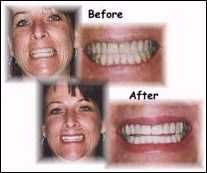Gum-lifts (gingivectomy) involve the removal of gum to make the teeth appear longer, and the gum-line even. People who have excess gum covering the front teeth and an upper lip that comes up high when they smile are often self-conscious about their "gummy" smile. An uneven gum-line can make the teeth appear to have different lengths, which takes away from the appearance of an attractive smile.
To correct these problems, the dentist numbs the area and removes the excess gum. The patient is instructed to use an antiseptic mouth rinse such as Peridex on a Q-tip and apply upward pressure on the gums as they heal. The procedure is not painful, but some mild discomfort can be expected a day or two after the procedure. The gum is not damaged due to the procedure as long as the dentist has experience, and removes the proper amount. The procedure can usually be completed in about 30 minutes. Gum-lifts generally cost about $75 to $175 per tooth. When I do a veneer case, I often include a gum-lift, if needed, at no extra cost.
Braces
Orthodontics or braces can improve the appearance of teeth in children and adults who have crooked teeth or teeth with wide gaps. The procedure usually takes about 18 to 24 months and costs about $3,500 to $4,500. Having teeth moved with braces is very time consuming, requires multiple visits (at least twenty) and can be uncomfortable. It is most useful for children to straighten their teeth. The procedure can improve the appearance of the face and jaw during growth.
I sometimes recommend braces to my adult patients for cosmetic reasons, but very few are interested. They would rather use other cosmetic options that get results faster, usually within two weeks, and often for less money.
Conclusion
Before you invest your time and money in cosmetic dentistry, you should consider the following: Is the dentist experienced in cosmetic dentistry and has he or she taken advanced continuing education courses in current techniques? Can you see before and after pictures and testimonial letters of people who have had similar treatment in the past? Does the dentist have imaging or presentation devices to help demonstrate how the procedure is done, and what results might be expected? If the answer is no to these questions, you should consider getting a second opinion.
Cosmetic dentistry is really more of an art than a science. I will often use a combination of the above methods to get the results that the patient is looking for. Training and experience matter and should be considered when choosing a dentist for cosmetic procedures. The most important thing to remember is that you and your dentist should talk about what outcome you expect before you begin treatment, and you should explore all the alternatives available in the exciting area of cosmetic dentistry before starting treatment.
[* All price ranges are estimates based on 1999 prices. Remember that prices will vary according to dental office overhead, location, expertise and experience of the dentist, and other factors.]


